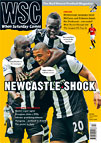 Matthew Barker examines US Ancona, whose supporters united to save the club after relegation and financial woe threatened its existence
Matthew Barker examines US Ancona, whose supporters united to save the club after relegation and financial woe threatened its existence
US Ancona 1905 were founded at the turn of the last century by a local who returned from a stint working at the docks in Liverpool, hence their red and white kit. They have appeared in Serie A twice, most recently during the 2003-04 season (with Goran Pandev, Dario Hübner and Dino Baggio among their ranks), though they dropped straight back into the second tier with a miserly 13 points from their 34 games.
That same summer they were declared bankrupt and demoted to the old Serie C2, a move that was rather overshadowed by similar events at Napoli. Ancona made it back up to Serie B within two years, under the patronage of the Schiavoni family, owners of a national electronics company based in the town. When the business was hit by the economic downturn, the football club quickly became of secondary importance.
There then came the involvement of the Centro Sportivo Italiano (CSI), a Catholic Church sports organisation that bought an 80 per cent stake in the club in 2007. With the Vatican’s approval, the plan was to build a team that would help promote Christian values on the field of play. It all ended in unseemly squabbles a few months later, with Ancona complaining that a promised €1 million (£875,000) had never materialised. CSI were disgruntled after the club dragged their heels over an agreement to open up charities in both Italy and Africa.
Forming some sort of supporters’ group had already been discussed during that traumatic summer of 2004, but it wasn’t until last year, and further financial woe, that fans really began to organise themselves. The best part of €4m had to be found to ensure that the club would stay in Serie B. It wasn’t, so i Dorici were thrown out of professional football, left to start again in the Eccellenza, the amateur regional leagues.
Sosteniamolancona (Let’s Support Ancona) was formed shortly after and quickly attracted a core group of 800 members. Things moved fast, with the group calling on the help of Supporters Direct’s European arm and granted a sympathetic audience by new club president Andrea Marinelli. Having won the Eccellenza Marche league (and both the regional and national versions of the Coppa Italia for teams at that level), the club were promoted up to the fifth level Serie D at the end of last season. It was a key moment, not just in terms of footballing progress, but also because it meant that under Italian law Ancona were now recognised as a limited company (only a handful of Italian clubs have actually floated on the stock exchange). Supporters could now purchase shares and were granted a two per cent stake in the club, with two representative directors on the board.
Ancona fans have generally gravitated towards the political left and are known for being well-organised and vocal in their protests. There has, of course, been an active tradition of supporters’ clubs and the ultra movement since the early 1960s. While various initiatives have taken root at Cavese, Venezia, Roma and Modena, among others, actual trusts in the style of UK models have been slow to catch on. There’s a cultural difference at play here – a subtle but crucial one.
Fans identify with the team, not the club. There is too much distrust between boardrooms and supporters. Ownership has always been jealously guarded, and fans can quickly spoil the public image of a successful patron doing their bit for civic pride. Then there is the suspicious relationship between the official supporter groups and the ultra. The latter think the former are too closely entwined with authority.
This is the challenge that Sosteniamolancona now face. Marinelli has not had the best relationship with the Curva Nord at the Stadio del Conero. But, after heavy-handed policing before a recent derby at Rimini, the president formed a closer bond with supporters, expressing solidarity with the travelling fans and even standing with them in the curva for a recent home game.
For a while it looked like the supporters’ trust were getting caught in the middle of an ugly spat between directors and ultras, following accusations of counterfeit ticketing and the ongoing bugbear of the tessera del tifoso identity card, which was introduced by the government last season.
The Ancona trust has taken a real step towards giving fans more say in the running of their club. They have already been involved in commercial activities and have attracted the interest of the national media. Foreign owners have come in at Roma, and Juventus are justly proud of their new self-owned stadium. But the changes at Ancona may well prove to be equally significant, especially in the cash-stricken lower leagues of Italian football.
From WSC 298 December 2011